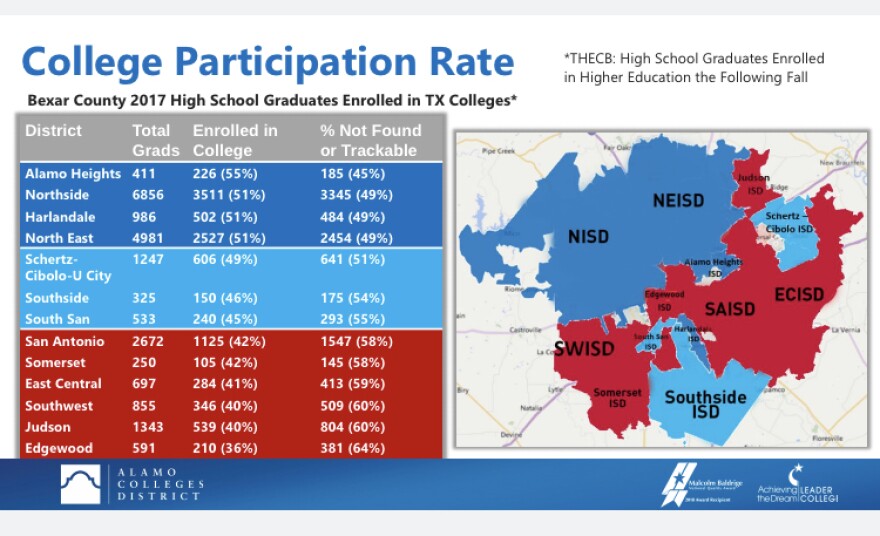The Alamo Colleges District will begin recruiting high school seniors for its new PROMISE program this fall, as funding commitments to sustain the free tuition program continue to be nailed down.The community college system’s board of trustees voted Saturday to start recruitment efforts for phase one of the PROMISE program, which will provide free tuition to seniors who graduate from 25 San Antonio high schools with a high concentration of poverty beginning in the fall of 2020.
The district plans to extend the same offer to seniors from Bexar County’s remaining high schools the following year.
The goal of the program is to make college affordable to everyone in Bexar County, boosting San Antonio’s low college-going rate and filling a need for more skilled labor. According to the district’s analysis of state data, 49% of San Antonio high school graduates enroll in a Texas college or university, but only 33% earn a degree.
The district hopes to increase college enrollment to 70% by 2025.
“We’ve always had the value of inclusive growth, but now we have a very strong economic argument,” said Bob McKinley, vice chancellor for economic and workforce development. “We know that what holds back our students are two main factors: affordability and accessibility. And what are the answers? Our one-two punch from a policy standpoint on affordability is PROMISE.”
Alamo Colleges expects 90% of the cost of the PROMISE program to be supported by state and federal grants during the first year, because most of the students in the first phase will qualify for the Pell grant and other forms of income-based financial aid.

But the support of local government and other groups becomes more critical as the program ramps up and more middle class families opt in. As a last dollar scholarship, AlamoPROMISE would fill in the gap after other scholarships and grants are applied to the cost of tuition.
In a presentation to the board Saturday, grants development director Stephanie Vasquez said that Alamo Colleges has $450,000 in pledged support for PROMISE so far, mostly from Frost Bank, Wells Fargo and JP Morgan Chase.
Vasquez said Alamo Colleges wants to provide a clear message to students: “If you want to pursue higher education, if you are interested in social mobility for yourself and your family, we will support you.”

San Antonio Mayor Ron Nirenberg and Bexar County Judge Nelson Wolff are vocal supporters of the scholarship. Alamo Colleges spokeswoman Kristi Wyatt said financial support from the city and county is expected for the 2020-2021 school year, but it won’t be final until the city council and the county commissioners work through their budget plans.
Alamo Colleges employees predict the PROMISE program will need almost $27 million dollars from local sources over the next five years to fund scholarships. But they also expect the program to generate $95 million in revenue from state and federal grants.
FY2020 Operating Budget
District trustees also approved a $385 million operating budget for fiscal year 2020 Saturday, including $453,000 for three AlamoPROMISE recruitment staff.
Diane Snyder, vice chancellor of finance and administration, told the board that Alamo Colleges has $18.7 million more in revenue expected this year due to enrollment growth, an increase in property tax value and a boost in state performance incentives.
“It’s a great year, but it’s not back to where we were, and we probably never will be back to where we were (with state funding),” Snyder said.
About half of the additional revenue in the budget is being used for the district’s student enrollment and success initiatives, and the other half will be used for raises and stipends for faculty and staff.
Key elements of the budget include:
- living wage increase for hourly workers (approved in March; effective in September)
- 3% raise for faculty and staff (effective in January)
- additional stipends for nursing, health, manufacturing and IT faculty (effective in January)
- health center pilots at San Antonio College and Palo Alto College
- staff for advocacy center at all five colleges providing basic needs like food and shelter
- continued support for the expansion of dual credit for high school students
- growth of online program
- enrollment coaches to help more students register for classes
- experiential learning program to increase internships and other on-the-job training opportunities
Camille Phillips can be reached at Camille@tpr.org or on Twitter @cmpcamille



